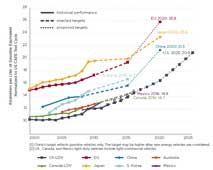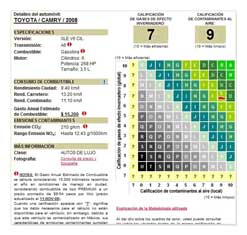
Mexico’s Automotive Fuel Economy Policy
1.0 Background
On July 12, 2012, the Government of Mexico officially published proposed regulations of CO2 emissions and the fuel economy equivalent for new passenger vehicles (cars, pickup trucks, and SUVs) mandating an average new car fleet average fuel economy of 14.9 km/L (6.7 L/100km, 35 mpg) in 2016. The proposal is patterned on U.S. National Highway Transportation Safety Administration (NHTSA) 2012–2016 standards and represents the final step in harmonizing passenger vehicle fuel economy / greenhouse gas standards throughout North America during that time frame. Publication of the proposed regulations in the Diario Oficial de la Federación opened a 60-day public comment period. The agencies involved will respond to comments, make any necessary adjustments to the proposal, and publish the final standard.
The regulation would create the only vehicle fuel economy standards in Latin America. A full summary of key elements of the proposal regulations is available from the International Council on Clean Transportation.
Comparison of global standards for CO2 and fuel economy, in terms of fuel economy (km/L) as measured on the U.S. CAFE test cycle

Source: The International Council on Clean Transportation
1.1 The Mexico Light-Duty Vehicle Fleet
Mexico had a car ownership rate of 276 vehicles/1000 people as of 2009. Light-duty vehicle (LDV) sales have grown rapidly since 1995, following a major market contraction in 1994. Since 1995, the annual growth rates averaged about 23% for cars, about 18% for trucks, and about 22% for cars and trucks combined.
1.2 Status of LDV fleet fuel consumption/CO2 emissions
New light vehicles sold in 2011 averaged 13.1 km/L, up from 11.8 km/L in 2008 (as measured on the U.S. CAFE test cycle), an 11% increase in fuel efficiency and an annual rate of improvement of 3.5%. In terms of CO2 emissions, new vehicles decreased from a fleet average of 198 gCO2/km in 2008 to 180 gCO2/km in 2011, a 9.3% reduction.
Compared to the U.S., vehicles sold in Mexico tend to be smaller (average footprint of 4.1 m2 as opposed to 4.5 m2) and less powerful (approximately 25% lower for manufacture year 2008). At the same time, the average fuel economy of new vehicles in Mexico is higher (U.S. was 12.2 km/l in 2011), which means that Mexico is starting out with higher efficiency than the U.S. and requires a lower annual rate of improvement—2.6% compared to 3.7%. As a result, the manufacturers have less of a hurdle to overcome to meet the proposed standards.
2.0 Regulatory Policies
2.1 National Standard
On July 12, 2012, the Government of Mexico officially published proposed regulations of CO2 emissions and the fuel economy equivalent for new passenger vehicles (cars, pickup trucks, and SUVs) mandating an average new car fleet average fuel economy of 14.9 km/L (6.7 L/100km, 35 mpg) in 2016. The proposal is patterned on U.S. National Highway Transportation Safety Administration (NHTSA) 2012–2016 standards and represents the final step in harmonizing passenger vehicle fuel economy / greenhouse gas standards throughout North America during that time frame. Publication of the proposed regulations in the Diario Oficial de la Federación opened a 60-day public comment period. The agencies involved will respond to comments, make any necessary adjustments to the proposal, and publish the final standard.
This is the first national standard in Mexico to set targets in accord with the recently adopted general Law on Climate Change.
The proposal is for a regulation on new-vehicle emissions of CO2 in grams per kilometer, and provides the equivalent regulatory metrics for fuel economy in km/L. The overall goal is to achieve an average new-vehicle fuel economy of 14.9 km/L for the model year 2016. This overall goal is not a standard for each individual vehicle, but refers to the fleet average of all passenger cars and light trucks that are sold in Mexico by 2016. The regulation would be implemented for new vehicles from model year 2014 through 2016, and credits generated in 2013 can be used toward compliance in the following years. Automakers must submit data for each year and, if the target is exceeded in any year, credits can be counted forward and backward throughout the full period of the regulation, allowing greater flexibility to automakers. Also, manufacturers can pool compliance for additional flexibility.
Manufacturers must comply with standards that will vary based on the sales-weighted average size and composition of the vehicles they sell. Separate compliance curves based on the vehicle size or “footprint” (the area between the four wheels of the vehicle, in square meters) are provided for two categories, passenger cars and light trucks (SUVs, minivans, pickups). The regulation pertains to light vehicles with gross vehicle weights up to 3,857 kg.
The proposal is based upon the U.S. NHTSA Corporate Average Fuel Economy (CAFE) curves for passenger cars and light trucks. It does not include technology credits of any sort, but does include 1% and 2% reductions from the original U.S. fuel economy targets for passenger vehicles and trucks, respectively, in order to add flexibility for Mexico-specific technology deployment strategies. The technologies considered in the modeling of the expected compliance with the regulation are existing technologies that are present in other markets, and the regulation does not require fleet composition shifts or advanced technologies like hybrids and diesels that are currently more costly.
The expected effects of the regulation, as evaluated by the Instituto Nacional de Ecología , are estimated as follows over the period from 2013 to 2030:
- Reduction in fuel consumed: 70 billion liters
- CO2 emissions avoided: 170 million tons of CO2
- Health benefits due to diseases and deaths averted (through reduced upstream pollutant emissions): 4,170 million pesos (approximately $314 million)
- Fuel savings equivalent to 513 billion pesos (US$39 billion), with federal government savings of 103 billion pesos (US$8 billion) associated with fuel subsidies.
2.2 Import restrictions
There are import restrictions on used cars in Mexico. Only used cars that are 10 years old – nothing newer, nothing older- can be imported into Mexico. So the model year that may be imported changes each year. This is designed to curtail the flood of ‘vehiculos chatarra’ or jalopies, clogging Mexican streets.
New Vehicles
The Mexico auto market is very dynamic in the sense that it produces, sells, exports, and imports large volumes of vehicles at the same time. About half of the new-sale vehicles are made domestically, half are imported. Three quarters of produced vehicles in Mexico are exported. But in general, Mexico is a “net” auto exporter – it exports more vehicles than it imports and sells domestically.
Second Hand Vehicles
There are import restrictions on used cars in Mexico. Only used cars that are 10 years old – nothing newer, nothing older- can be imported into Mexico. Used vehicles of a condition which are restricted or prohibited from circulating in their own country of origin, will be prohibited from importation into Mexico.
2.3 Technology mandates/targets
There are no technology mandates in Mexico.
3.0 Fiscal Measures and Economic Instruments
3.1 Fuel Taxes
N/A
3.2 Fee-bate
N/A
3.3 Buy-back
N/A
3.4 Other tax instruments
N/A
3.5 Registration fees
N/A3.6 R&D
N/A
4.0 Traffic Control Measures
4.1 Priority lanes
Mexico City incorporated a traffic control program in 2000. Dubbed the “zero-zero” program, certain vehicles that are low emission can drive all week, while other, higher emission vehicles, cannot drive on certain days. Cars are labelled as ‘hoy no circula’, or ‘no driving today’, according to their plate numbers.
4.2 Parking
N/A
4.3 Road pricing
N/A
N/A
5.0 Information
5.1 Labeling
N/A
5.2 Public Info
Mexico has created a website (Portal de Indicadores de Eficiencia Energética y Emisiones Vehiculares) that allows consumers to check the fuel economy of particular vehicles. The objective of this portal is to provide consumer information on the technical characteristics of vehicles and to condense into two grades, which combine the attributes of performance and emissions in order to take better decisions and help to improve the environment.
The importance of taking into account the energy efficiency of the car is because, on the one hand, consumers can reduce their fuel consumption while on the other hand reduce their emissions of carbon dioxide, which contributes to global climate change. In addition, vehicles with lower emissions of local pollutants, will result in a decrease in harmful effects to health of the population.
A sample from the consumer fuel economy information website Portal de Indicadores de Eficiencia Energética y Emisiones Vehiculares

5.3 Industry reporting
The text above is a summary and synthesis of the following sources:
- An, Feng and Kate Blumberg. The Case for Mexico to Improve Fuel Economy. 9 January 2005.http://www.icet.org.cn/adminis/uploadfile/reference/20050118.pdf
- Blumberg, Kate. “Mexico light-duty vehicle CO2 and fuel economy standards.” The International Council on Clean Transportation. July 2012. http://www.theicct.org/mexico-ldv-co2-standards; http://www.theicct.org/sites/default/files/publications/ICCT_PolicyUpdate_MX-LDV_July2012final.pdf
- Compilation of Foreign Motor Vehicle Import Requirements. United States Department of Commerce International Trade Administration Office of Transportation and Machinery. 2011. http://trade.gov/static/autos_report_tradebarriers2011.pdf
- “Country Analysis Briefs: Mexico”. Energy Information Administration, 2009. http://www.eia.doe.gov/emeu/cabs/Mexico/Full.html
- German, J. “Impact of Standards on Industry, Consumers and Economy.” International Council on Clean Transport. Passenger Vehicle Efficiency Workshop, Mexico, March 2010.http://www.theicct.org/documents/0000/1424/German_ICCT_Standard_impacts.pdf
- Cortés, M. “Analysis of fuel economy standard options for new passenger vehicles in Mexico”. Secretaria de Medio Ambiente y Recursos Naturales Mexico, June 2009. http://pre2010.theicct.org/documents/IIC_esquemas_sacramentoFINAL.pdf
- List of countries by carbon dioxide emissions. http://en.wikipedia.org/wiki/List_of_countries_by_carbon_dioxide_emissions
- List of countries by vehicles per capita. http://en.wikipedia.org/wiki/List_of_countries_by_vehicles_per_capita
- Lutsey, N. “Design Considerations for Fuel Economy/GHG Standards”. International Council on Clean Transport, Presentation from Climate Change Mitigation: The Importance of Passenger Vehicle Standards, March 2010. http://www.theicct.org/information/workshops/climate_change_mitigation
- “Mexico: ‘Green Tax’ in Works To Exempt Hybrid Drivers, Penalize Owners of Bigger and Older Vehicles.” Edmunds Inside Line. September 2008. http://www.insideline.com/car-news/mexico-green-tax-in-works-to-exempt-hybrid-drivers-penalize-owners-of-bigger-and-older-vehicles.html








